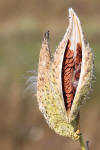WILD
FOODIES' HOME PAGE
PLANT PROFILE LIST
NAME: Milkweed
SPECIES / FAMILY: Asclepias Syriaca / Apocynaceae
OTHER COMMON NAME(S): Butterfly Flower, Silkweed
CONDITIONS: sun
|
PARTS: |
EDIBLE |
TASTE |
RAW/COOK |
SEASON |
|
All |
|
|
|
|
|
Shoots |
|
spinach |
COOK |
Spring |
|
Leaves |
|
|||
|
Flower/Buds |
|
flowers/sweet |
COOK |
Summer |
|
Fruits |
|
|
|
|
|
Roots |
||||
|
Seeds |
|
|
||
|
Nuts |
|
|
|
|
|
Pods |
|
peas |
|
|
|
Stalk/Stem |
|
|
|
|
|
Bark |
|
|
|
|
PORTION: small-medium
COMMENT: Milkweed requires careful preparation, see below. // “Unopened flower buds – cooked like brocalli. Flowers and young flower buds – cooked, mucilaginous texture and a pleasant flavour, they can be used as a flavouring and a thickener in soups etc. The flower clusters can be boiled down to make a sugary syrup. The flowers are harvested in the early morning with the dew still on them. When boiled up they make a brown sugar. Young seed pods, 3 - 4 cm long, cooked. They are very appetizing. Best used when about 2 - 4cm long (1-1.5 inches) and before the seed floss forms, on older pods remove any seed floss before cooking them. If picked at the right time, the pods resemble okra. The sprouted seeds can be eaten. An edible oil is obtained from the seed. The latex in the stems is a suitable replacement for chicle and can be made into a chewing gum. It is not really suitable for use in tyres. The latex is found mainly in the leaves and is destroyed by frost. Yields are higher on dry soils.” (1)
PREPARATION by the GREEN DEANE: Young shoots, leaves and pods boiled in several changes of water. That can vary greatly, some are not bitter some are. Bitter ones should be boiled in copious amounts of water at least once. Whether cold water to start or boiling water to start will have to be learned by experimenting. If the cooked vegetable is bitter, try a different method. Gather leaves in early spring when they first open. Gather seed pods in summer. Parboil for three minutes, then discard bitter water and replace with clean boiling water. (Cold water tends to fix bitterness, other times hot water does.) Repeat this process three times, then cook the leaves for 15 minutes before seasoning them. A pinch of soda can be added during cooking to break down the fiber and improve flavor. The young shoots under six inches long, found during the spring are used as a vegetable. Remove the fuzz on the shoot by rubbing it off. Preparation is the same as for the leaves. Collect flower buds and flowers during the summer. Dip buds in boiling water for one minute, batter and deep fry. When cooked like broccoli, buds are similar to okra. The flower clusters may also be battered and fried. After cooking, buds, flowers and leaves can be frozen. Use like okra in soups. A bit of baking soda in the water will help break down the tough fibers in the seed pod. Parboiled for several minutes, the young pods may be slit, rolled in a cornmeal/flour mixture and fried or frozen for future use. https://www.eattheweeds.com/asclepias-some-like-it-hot-some-like-it-cold-2/
CAUTION: Milkweed contains latex, to which some people are allergic, from slightly to severely. “Although no specific reports have been seen for this species, many, if not all, members of this genus contain toxic resinoids, alkaloids and cardiac glycosides. They are usually avoided by grazing animals. The older leaves are poisonous if eaten in large quantities. The plant contains cardioactive compounds and is potentially toxic.”(1)
NUTRITION/MEDICINAL:
https://www.webmd.com/vitamins/ai/ingredientmono-291/swamp-milkweed
“Anodyne; Contraceptive; Diaphoretic; Diuretic; Emetic; Expectorant;
Homeopathy; Purgative; Warts.” (1)
LOOK-A-LIKES: Milkweed, Butterfly & Milkweed, Swamp
POISONOUS LOOK-A-LIKES: Dogbane https://pfaf.org/user/plant.aspx?LatinName=Apocynum+cannabinum & https://en.wikipedia.org/wiki/Apocynum_cannabinum
OTHER USES: Other Uses: Adhesive; Fibre; Gum; Latex; Oil; Pollution; Stuffing; Wick. (1)
SOURCE LINKS (may include nutritional and medicinal info, cautions, and other uses):
- https://pfaf.org/User/plant.aspx?LatinName=Asclepias+syriaca
- https://www.eattheweeds.com/asclepias-some-like-it-hot-some-like-it-cold-2
- https://en.wikipedia.org/wiki/Asclepias_syriaca
- http://www.foragingtexas.com/2008/08/milkweed.html (good photos)
- http://www.ediblewildfood.com/milkweed.aspx (good photos)
- https://plighttofreedom.com/?s=milkweed
- https://practicalselfreliance.com/milkweed
- http://www.theheartofnewengland.com/food/veg/milkweed-pods-sauteed.html
- http://tacticalintelligence.net/blog/how-to-eat-milkweed.htm
- https://farmandforagekitchen.com/blog/5-ways-to-enjoy-milk-weed-flowers
- https://commonsensehome.com/milkweed
RELATED SPECIES WITH EDIBLE PARTS, BUT STRONG CAUTIONS:
• Butterflyweed: https://www.pfaf.org/user/plant.aspx?LatinName=Asclepias+tuberosa
• Fewflower milkweed: https://www.pfaf.org/user/Plant.aspx?LatinName=Asclepias+lanceolata




